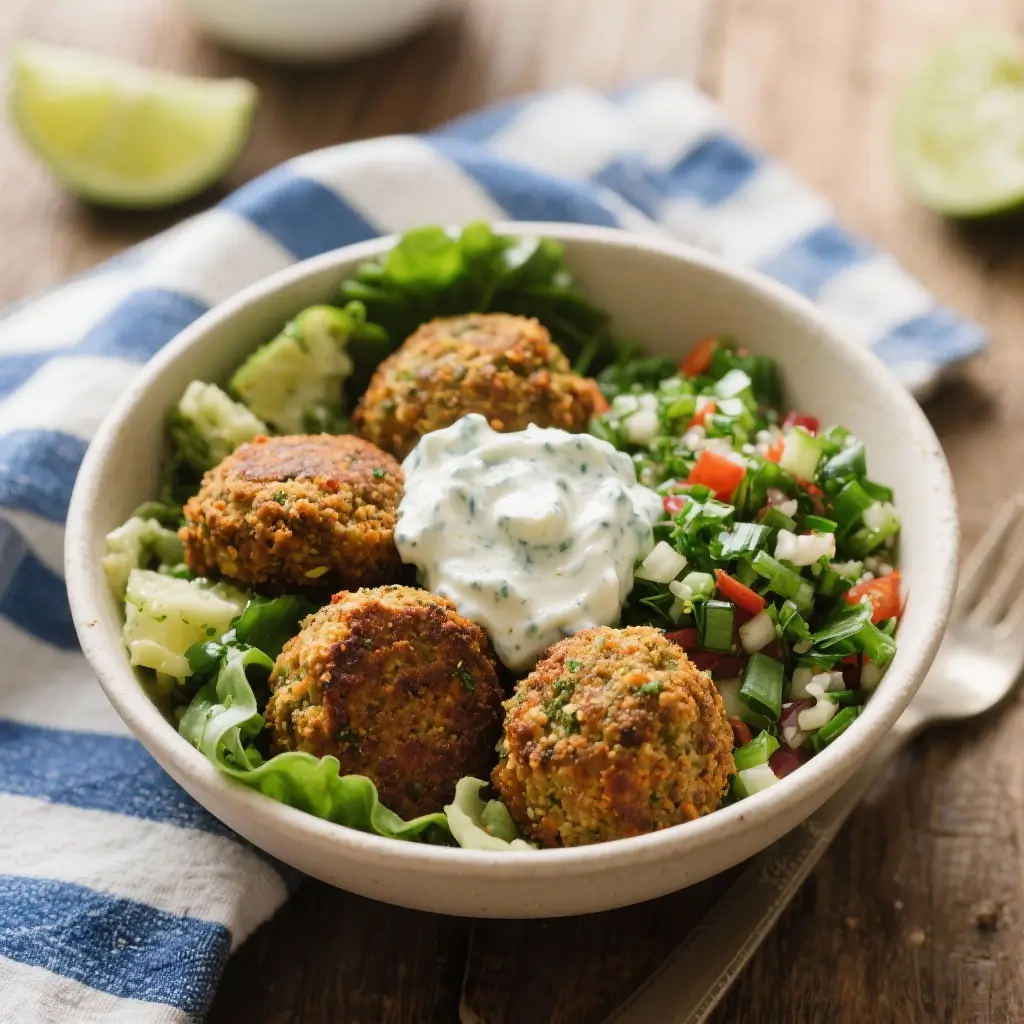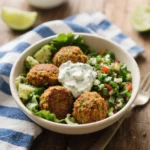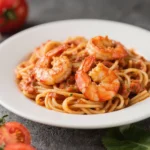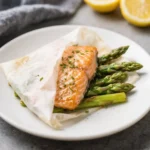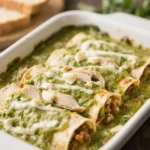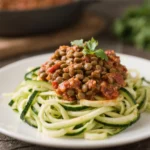Greek Falafel Bowls with Tzatziki & Tabbouleh
Looking for a vibrant, nutrient-packed meal that combines the bold flavors of the Mediterranean with plant-based goodness? These Greek Falafel Bowls with Tzatziki and Tabbouleh are your answer. A modern twist on traditional Middle Eastern cuisine, this dish brings together crispy chickpea falafel, creamy tzatziki sauce, fresh tabbouleh salad, and a medley of wholesome ingredients to create a satisfying bowl that’s as beautiful as it is delicious. Perfect for meal prep, weeknight dinners, or entertaining guests, this recipe celebrates freshness, balance, and flavor in every bite.
The History
Falafel, one of the most iconic dishes of the Middle East, has roots that stretch back centuries. While its exact origin is debated—some trace it to Egypt, others to Palestine or Lebanon—it has become a staple across the region. Traditionally made from ground fava beans or chickpeas, seasoned with herbs and spices, then deep-fried into golden balls, falafel was originally a meatless option during religious fasting periods. Over time, it evolved into a beloved street food, often served in pita bread with vegetables and tahini sauce.
Greek cuisine, known for its emphasis on fresh produce, olive oil, and yogurt-based sauces like tzatziki, shares many culinary elements with its Levantine neighbors. This fusion recipe bridges these two rich traditions by pairing falafel with classic Greek sides: tabbouleh (though originally Levantine, it’s widely enjoyed in Greece) and cool, garlicky tzatziki. The result is a harmonious blend of cultures on a single plate—where chickpea fritters meet Mediterranean freshness in a celebratory bowl format that reflects today’s global palate.
Ingredients Breakdown
This dish is built on layers of flavor and texture, each component contributing its own unique character:
- Chickpeas: The star ingredient in falafel, packed with protein and fiber. Using dried, soaked chickpeas (not canned) ensures the perfect texture—crispy outside, tender inside.
- Fresh Herbs: Parsley and cilantro add brightness and depth. They’re essential for authentic falafel flavor.
- Aromatics: Onion, garlic, and green onion build the savory base.
- Spices: Cumin, coriander, paprika, and a pinch of cayenne deliver warmth and earthiness without overwhelming heat.
- Tzatziki: Made from Greek yogurt, cucumber, garlic, lemon juice, and dill, this cooling sauce balances the spiced falafel beautifully.
- Tabbouleh: A parsley-heavy salad with tomatoes, cucumber, bulgur wheat (or quinoa for gluten-free), mint, olive oil, and lemon juice—refreshing and herbaceous.
- Bowl Base: Options include fluffy couscous, quinoa, brown rice, or greens like romaine or baby spinach.
- Toppings: Sliced cucumbers, cherry tomatoes, red onion, kalamata olives, and crumbled feta cheese elevate the bowl with color and tang.
- Olive Oil: Used both for frying (optional) and dressing—extra virgin olive oil adds richness and authenticity.
Every ingredient is chosen not just for taste but also for nutritional synergy, making this bowl a powerhouse of plant-based nourishment.
Step-by-Step Recipe
Part 1: Make the Falafel
- In a large bowl, soak 1 cup of dried chickpeas in plenty of cold water for at least 12 hours (do not cook). Drain and rinse well.
- In a food processor, combine the soaked chickpeas, 1 small onion (roughly chopped), 4 garlic cloves, 1 cup fresh parsley, 1 cup fresh cilantro, 2 green onions, 1 tsp ground cumin, 1 tsp ground coriander, 1/2 tsp smoked paprika, 1/4 tsp cayenne pepper, 1 tsp salt, and 1/2 tsp black pepper.
- Pulse until the mixture resembles coarse sand—do not over-process into a paste.
- Add 2 tbsp chickpea flour (or all-purpose) and pulse again to bind. Test by forming a small patty; if it holds, it’s ready. If too wet, add more flour.
- Refrigerate the mixture for 30 minutes to firm up.
- Shape into small patties or balls (about 1.5 inches in diameter).
- Heat 1/4 inch of olive oil in a skillet over medium heat. Fry falafel in batches for 3–4 minutes per side until golden brown and crispy. Alternatively, bake at 400°F (200°C) on a parchment-lined tray for 20–25 minutes, flipping halfway, for a lighter version.
- Drain on paper towels and keep warm.
Part 2: Prepare the Tzatziki
- Peel and grate 1 medium cucumber. Place in a clean kitchen towel and squeeze out excess moisture.
- In a bowl, mix 1.5 cups Greek yogurt, the drained cucumber, 2 minced garlic cloves, 1 tbsp lemon juice, 1 tbsp olive oil, 1 tbsp fresh dill (chopped), 1/2 tsp salt, and freshly ground black pepper.
- Cover and refrigerate for at least 30 minutes to allow flavors to meld.
Part 3: Assemble the Tabbouleh
- If using bulgur: Pour 1/2 cup fine bulgur into a heatproof bowl, cover with 3/4 cup boiling water, and let sit for 20 minutes. Fluff with a fork and drain any excess liquid.
- If using quinoa: Rinse 1/2 cup quinoa, then cook in 1 cup water for 15 minutes. Let cool.
- In a large bowl, combine the cooled bulgur or quinoa with 1.5 cups finely chopped parsley, 1/2 cup chopped mint, 1 diced tomato, 1/2 diced cucumber, 1/4 cup finely chopped red onion, 3 tbsp olive oil, 2 tbsp lemon juice, 1/2 tsp salt, and pepper to taste.
- Toss well and chill for at least 15 minutes before serving.
Part 4: Build the Bowls
- Choose your base: cooked quinoa, brown rice, couscous, or mixed greens (about 3/4 cup per bowl).
- Arrange falafel (3–4 pieces), a generous scoop of tabbouleh, sliced cucumbers, halved cherry tomatoes, red onion rings, kalamata olives, and optional crumbled feta.
- Drizzle with tzatziki and a touch more olive oil or lemon juice if desired.
- Serve immediately with extra tzatziki on the side.
Tips
- Use dried, not canned chickpeas: Canned chickpeas contain too much moisture and will cause falafel to fall apart. Soaking dried chickpeas overnight is crucial for the right texture.
- Don’t skip chilling: Refrigerating the falafel mixture helps it hold shape during cooking.
- Keep falafel small: Smaller patties cook evenly and stay crispy.
- Squeeze cucumber thoroughly: Excess water will thin your tzatziki. A tight wring in a towel makes all the difference.
- Make ahead: All components can be prepared 1–2 days in advance. Store separately in airtight containers. Assemble bowls just before eating to maintain texture.
- For crispier baked falafel: Spray patties lightly with oil and use a wire rack on the baking sheet for even air circulation.
- Boost flavor: Add a pinch of sumac or za’atar to the falafel mix or sprinkle over the finished bowl for a tangy, aromatic kick.
Variations and Customizations
- Gluten-Free: Use quinoa instead of bulgur in the tabbouleh and ensure chickpea flour is used in the falafel.
- Vegan: Omit feta or use a plant-based alternative. Substitute dairy-free yogurt (coconut or almond-based) for tzatziki.
- Low-Carb: Serve over a bed of romaine, arugula, or kale. Skip grains and increase non-starchy vegetables.
- Protein Boost: Add grilled halloumi, marinated tofu, or a hard-boiled egg.
- Spice It Up: Mix harissa or sriracha into the tzatziki, or add jalapeños to the bowl.
- Mediterranean Grain Swap: Try farro, freekeh, or Israeli couscous as a heartier base.
- Herb Variations: Add basil or tarragon to tzatziki for a different herbal note.
- Kid-Friendly: Shape falafel into nuggets, serve with mild tzatziki, and skip raw onions.
Health Considerations and Nutritional Value
These Greek Falafel Bowls are not only delicious but also nutritionally balanced. Here’s why they’re a smart choice for health-conscious eaters:
- High in Plant-Based Protein: Chickpeas provide about 7–8 grams of protein per 1/2 cup, supporting muscle repair and satiety.
- Fiber-Rich: With chickpeas, whole grains, and vegetables, this meal delivers 10+ grams of fiber per serving, promoting digestive health and stable blood sugar.
- Healthy Fats: Olive oil and nuts (if added) contribute monounsaturated fats, which support heart health.
- Probiotics: Yogurt in tzatziki contains beneficial bacteria for gut health (choose live-culture varieties).
- Vitamins & Antioxidants: Fresh herbs, tomatoes, cucumbers, and lemon juice offer vitamins A, C, K, and antioxidants like lycopene and flavonoids.
- Low in Saturated Fat: Especially when baked, this dish is naturally low in unhealthy fats.
- Iron & Folate: Chickpeas and leafy greens supply non-heme iron and folate, important for energy and cell function.
Nutritional Estimate (per bowl, with quinoa, baked falafel, tzatziki, tabbouleh, and veggies):
Calories: ~550 | Protein: 18g | Carbohydrates: 65g | Fiber: 14g | Fat: 24g (mostly unsaturated) | Sodium: 750mg (adjustable)
Note: Sodium can be reduced by using low-salt yogurt, less feta, and limiting added salt. Those with hypertension or kidney issues should monitor portions accordingly.
Ingredients
For the Falafel:
- 1 cup dried chickpeas, soaked overnight (do not cook)
- 1 small yellow onion, roughly chopped
- 4 garlic cloves
- 1 cup fresh flat-leaf parsley, tightly packed
- 1 cup fresh cilantro, tightly packed
- 2 green onions, chopped
- 1 tsp ground cumin
- 1 tsp ground coriander
- 1/2 tsp smoked paprika
- 1/4 tsp cayenne pepper (optional)
- 1 tsp salt
- 1/2 tsp black pepper
- 2–3 tbsp chickpea flour (or all-purpose flour)
- Olive oil, for frying or baking
For the Tzatziki:
- 1 medium cucumber, peeled and grated
- 1.5 cups plain Greek yogurt (or dairy-free alternative)
- 2 garlic cloves, minced
- 1 tbsp lemon juice
- 1 tbsp extra virgin olive oil
- 1 tbsp fresh dill, chopped
- 1/2 tsp salt
- Freshly ground black pepper
For the Tabbouleh:
- 1/2 cup fine bulgur wheat (or quinoa, for GF)
- 1.5 cups finely chopped fresh parsley
- 1/2 cup chopped fresh mint
- 1 medium tomato, diced
- 1/2 cucumber, diced
- 1/4 cup finely chopped red onion
- 3 tbsp extra virgin olive oil
- 2 tbsp fresh lemon juice
- 1/2 tsp salt
- Pepper to taste
For Serving:
- Cooked quinoa, brown rice, or couscous (or mixed greens)
- Sliced cucumbers
- Halved cherry tomatoes
- Sliced red onion
- Kalamata olives
- Crumbled feta cheese (optional)
- Extra tzatziki and lemon wedges
Directions
Follow the detailed step-by-step instructions outlined above under “Step-by-Step Recipe.” Each component—falafel, tzatziki, tabbouleh, and assembly—is clearly broken down for easy preparation. Be sure to read through all steps before beginning to ensure proper timing and ingredient readiness.
FAQ
Can I make these falafel ahead of time?
Yes! Prepare the falafel mixture up to 24 hours in advance and store covered in the fridge. You can also fry or bake them ahead and reheat in a 350°F oven for 10 minutes to restore crispness.
Can I freeze falafel?
Absolutely. Freeze uncooked or cooked falafel in a single layer on a tray, then transfer to a freezer bag. Cook from frozen—bake at 400°F for 25–30 minutes or pan-fry gently until heated through.
Why did my falafel fall apart?
Most likely due to using canned chickpeas (too moist) or over-processing the mixture. Always use dried, soaked chickpeas and pulse until coarse, not smooth.
Is tzatziki safe to leave out?
Due to the yogurt content, tzatziki should not sit at room temperature for more than 2 hours. Keep chilled until serving.
Can I use pre-made tabbouleh?
Yes, though homemade allows you to control freshness and sodium. Check labels for preservatives if buying store-bought.
Are these bowls kid-friendly?
Many children love the flavors, especially when falafel are shaped like nuggets. Serve with mild tzatziki and skip strong herbs or spicy elements if needed.
How long do leftovers last?
Components keep well for 3–4 days in the refrigerator. Store separately and assemble bowls fresh to prevent sogginess.
Summary
Greek Falafel Bowls with Tzatziki and Tabbouleh bring together the best of Mediterranean cuisine—crispy spiced chickpea falafel, cool herbed yogurt sauce, and a refreshing parsley-rich salad—all layered over a wholesome grain or green base. Packed with flavor, texture, and nutrition, this vibrant bowl is a celebration of plant-powered eating that satisfies both the palate and the soul.
